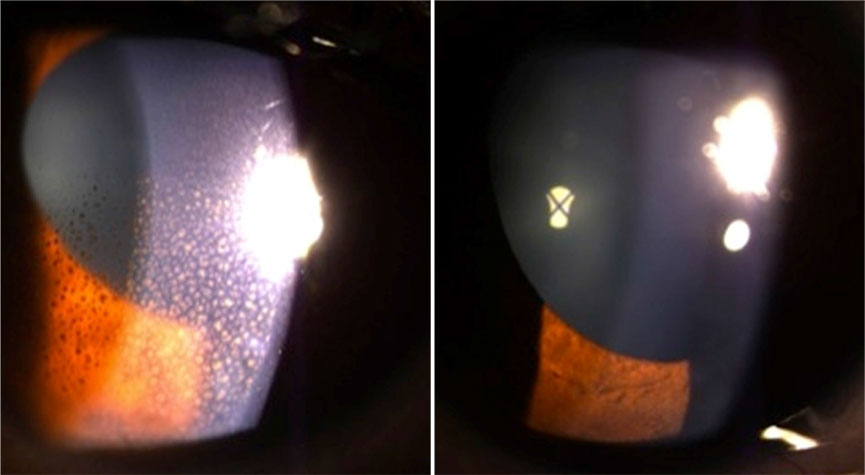Blink
Can You Guess October's Mystery Condition?
Download PDF
Make your diagnosis in the comments, and look for the answer in next month’s Blink.

Last Month’s Blink
Iris Melanoma
Written by Roopashree Hariprasad Vokuda, MD, and Hariprasad Vokuda, MD, Shree Hari Netralaya, Udupi, India. Photos by Dr. Hariprasad Vokuda.
A 59-year-old woman came to our clinic for a routine eye examination. On slit-lamp exam, a hyperpigmented iris lesion was noted in her right eye (Fig. 1). The lesion was seen inferotemporally with a feathery margin and iridocorneal involvement with corneal touch. A mild degree of corectopia was also noted. Gonioscopy showed tumor seeding in all quadrants. On dilation (Fig. 2), a localized secondary cataract was noted underneath the lesion. Fine-needle aspiration biopsy and ultrasound biomicroscopy provided confirmation of melanoma.
Iris melanoma is rare, representing 2% of all uveal melanomas, in contrast to iris nevus, which is common. Iris melanoma should be diagnosed quickly and treated promptly. Treatment can be in the form of sector iridectomy/iridocyclectomy, radioactive plaque brachytherapy, or enucleation. Metastasis can be seen in 2%-10% of all iris melanoma cases. It can be asymptomatic at presentation, as in our case, or the patient may notice a sudden increase in size of a preexisting nevus and may have cosmetic concerns, pain, change in vision, or raised intraocular pressure. The melanoma can be circumscribed or diffuse, sometimes involving more than two-thirds of the angle (ring melanoma). The ABCDEF guide for predicting if an iris nevus could become melanoma is: Age < 40 years. Blood in anterior chamber. Clock hour: inferior. Diffuse configuration. Ectropion/corectopia. Feathery margin. Other risk factors: angle involvement, secondary cataract, or glaucoma.
Read your colleagues’ discussion.
| BLINK SUBMISSIONS: Send us your ophthalmic image and its explanation in 150-250 words. E-mail to eyenet@aao.org, fax to 415-561-8575, or mail to EyeNet Magazine, 655 Beach Street, San Francisco, CA 94109. Please note that EyeNet reserves the right to edit Blink submissions. |